What are rocks?
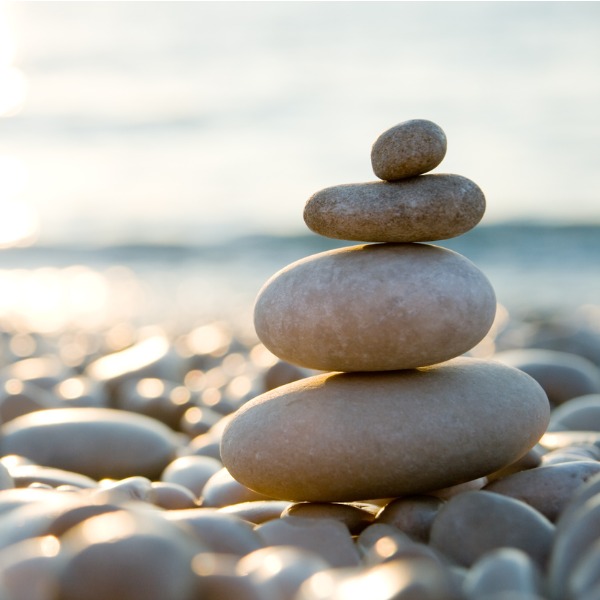
Balanced stones on a pebble beach (spooh, iStockphoto)

Balanced stones on a pebble beach (spooh, iStockphoto)
How does this align with my curriculum?
Learn about the types of rocks, the rock cycle, and weathering and erosion.
What Are Rocks?
Rocks are made up of two or more minerals. Rocks containing valuable minerals are called ore.
How do people classify rocks?
Rocks are often classified according to how they are formed.
Igneous Rock
Igneous rocks are rocks formed by the cooling and solidification of .
Did you know?
The word igneous comes from the Latin word “ignis” meaning fire.
Image - Text Version
Shown is a close-up colour photograph of pink, grey and black mottled rock.
The rock's surface fills the whole image. It appears to be flat, and matte. Most of the rock is pale peach, with patches of grainy black and grey mixed throughout.
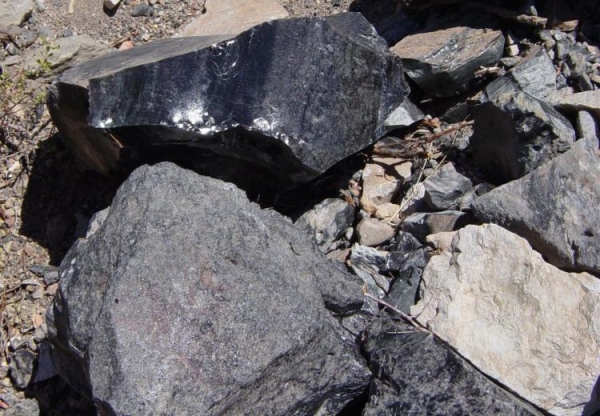
Image - Text Version
Shown is a colour photograph of three large boulders on a pile of smaller rocks.
The photograph is taken outdoors, looking down at the ground. The top rock is black and shines in the sun. The large rock below and to the right is pale grey and matte. The one on the bottom left is medium grey with a grainy texture.
Sedimentary Rock

Image - Text Version
Shown is a colour photograph of towers of brown rock near a cliff.
On the left of the photograph is a cliff with evergreen trees growing on the top. The rock of the cliff face appears soft. It is rounded with long vertical channels.
To the right, these channels become wider and wider gaps. The rock is separated into tall thin towers separate from the cliff. The towers have rounded, lopsided shapes, wider at the top than the bottom. Layers are visible in the texture of the rock, like flat pieces of dough piled on each other.
In the foreground, on the left, mounds of the same rock are covered with seaweed. This becomes smoother and flatter on the right.
Did you know?
Fossils are only found in sedimentary rock!
Examples of sedimentary rocks include limestone, shale, sandstone and conglomerate.
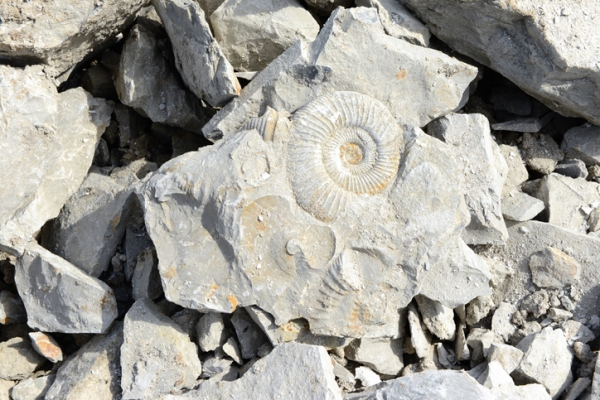
Image - Text Version
Shown is a colour photograph of pale grey rock textured with spiral shapes.
The camera is focussed on one large stone on a pile of similar rocks. It is mostly flat with sharp, jagged edges. Its surface is embedded with several ribbed, spiral shapes. These shapes are the same colour as the rock, as if they are a part of it.
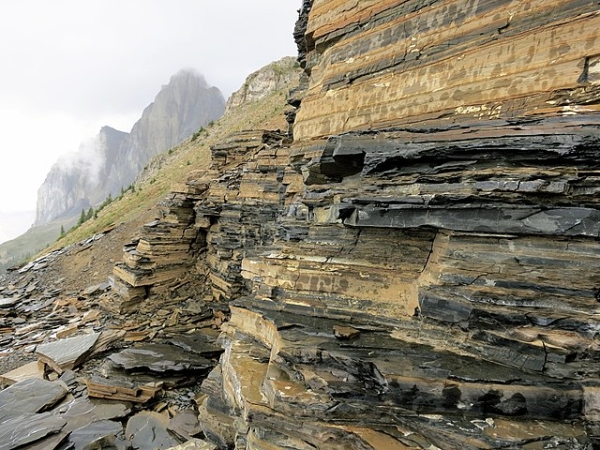
Image - Text Version
Shown is a colour photograph of sharp, flat layers of rock.
In the foreground the camera is focused on thin, horizontal layers of gold and dark grey rock. A steep cliff of this rock stretches to the top of the image. Thin, flat, jagged pieces are piled at the bottom of the cliff. It appears as if they have broken off the main layers.
In the background is a steep, grassy slope and a mountain peak obscured by cloud.
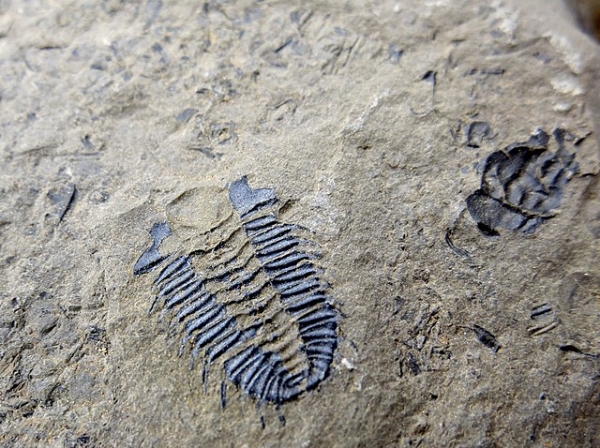
Image - Text Version
Shown is a colour photograph of beige rock embedded with the black shapes of small animals.
The surface of the rock fills the whole image. It is mostly flat with a rough texture. The camera is focused on two distinct black shapes in the centre. These are embedded into the surface of the rock. They look like shellfish, or perhaps insects.
The one on the left is oval shaped, with a segmented body bracketed by two long, ribbed structures that meet at the bottom. These have what look like tiny black feet along the outside.
The one on the right is smaller. It appears to have a round body and a half-moon shaped head. The remnants of three or four legs extend around it.
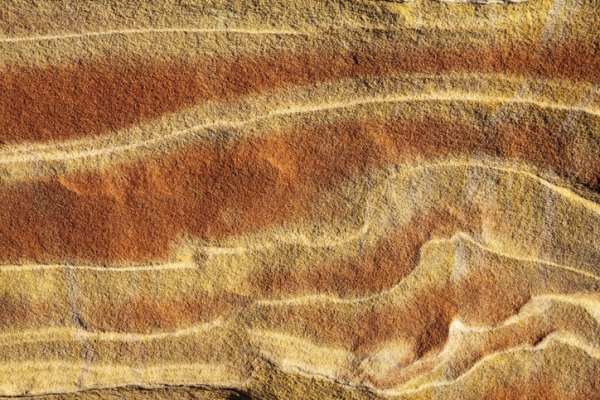
Image - Text Version
Shown is a colour photograph of rock with a wavy, grainy texture.
The surface of the rock fills the whole image. It appears mostly flat. But it has a texture of sand washed up on a shore. The ridges of waves are visible in the rough, grainy surface. The stone is a gold colour. The peaks of each wave are brighter gold. The valleys in between are darker, reddish gold.
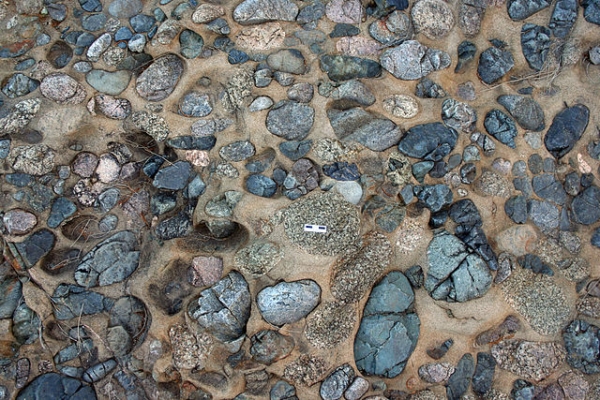
Image - Text Version
Shown is a colour photograph of beige rock embedded with many smaller rocks.
The surface of the rock fills the whole image. It looks a bit like chocolate chips mixed into cookie dough. The main part of the rock is smooth and beige. It binds the other pieces together. The smaller rocks are round and blueish grey. Some of them have come out of the beige surface, leaving round holes behind.
Metamorphic Rock
Metamorphic rocks are formed due to physical or chemical change to an existing rock. We call this process metamorphosis. Metamorphosis means a change in form. You may have heard this word used for the life cycle process that butterflies undergo when they change from larvae to adults.
Sedimentary, igneous and metamorphic rocks can become metamorphic rocks by being exposed to extreme heat and pressure, such as deep underground.
Examples of metamorphic rocks include marble, slate and gneiss.
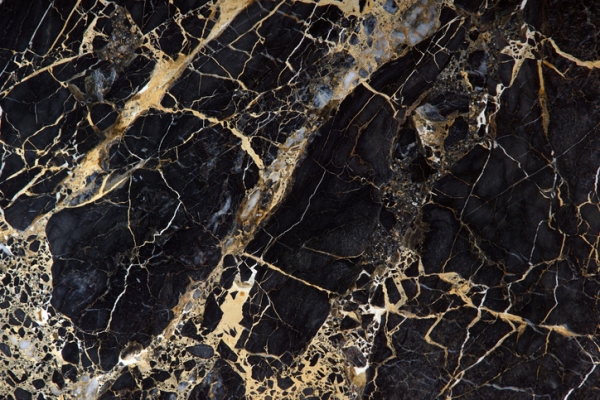
Image - Text Version
Shown is a colour photograph of black rock with pale yellow veins.
The surface of the rock fills the whole image. Most of it is black, with shades of very dark grey. Jagged and squiggly pale gold lines criss-cross the whole surface.
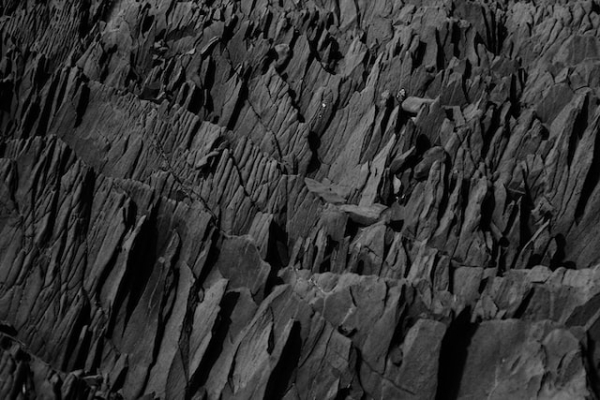
Image - Text Version
Shown is a colour photograph of thin layers of dark grey rock.
The rock wall fills the whole image. It is made up of thin, almost vertical layers. These form a jagged texture with many sharp points along each layer. There are broken pieces of rock in the crevices of the wall.
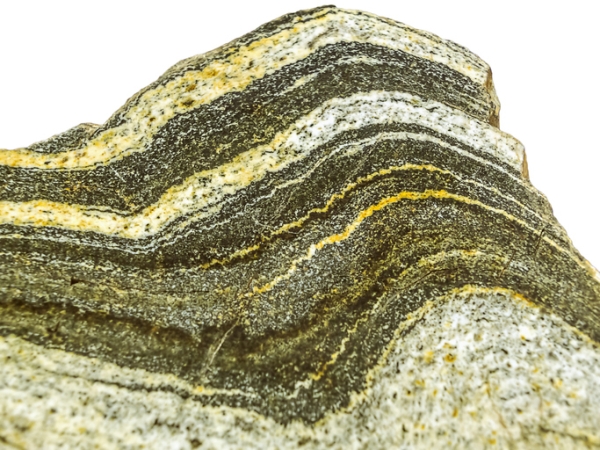
Image - Text Version
Shown is a colour photograph of rock with light and dark grey layers.
A corner of rock is shown against a white background. Thick and thin layers of dark and light grey speckled rock follow the curved shape of the top edge.
How do people use rocks?
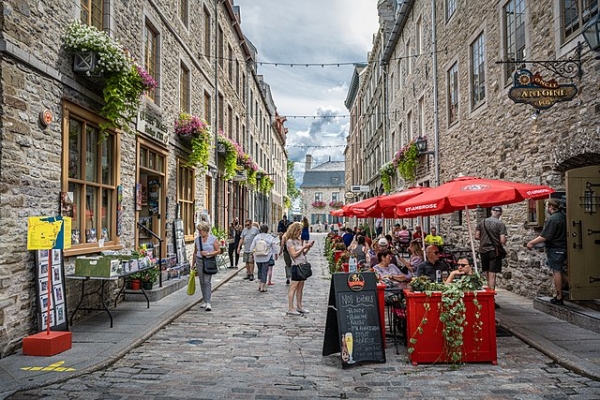
Image - Text Version
Shown is a colour photograph of a narrow street made of the same rocks as the buildings on both sides.
Almost all the structures in the image are made from similar, rectangular grey and beige rocks, fitted closely together. The rocks in the street are worn down so they are almost smooth. The rocks that make up the walls of the buildings are more distinct.
The only things not made from rock are the windows, and the plants in the boxes below them. An outdoor restaurant is set up along the street, with tables covered by red umbrellas.
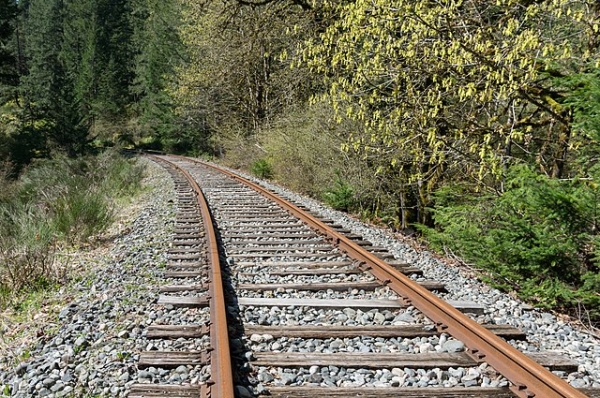
Image - Text Version
Shown is a colour photograph of tracks on a pile of small, pale grey rocks.
The tracks start at the bottom of the image and curve away into the distance. All the way along, they lie on a long, flat pile of grey rocks. This pile is higher than the land on either side of the tracks, where trees and shrubs grow close.

Image - Text Version
Shown is a colour photograph of a sculpture in the shape of a bear, with the faces of other creatures emerging from its body.
The sculpture is one piece of dark greenish grey rock, against a yellow background. The main shape is a large bear with a pointed snout and ears, leaning back on its hind legs. Four other faces are visible, emerging from the bear's back. Two look like people, and one looks like another bear. The fourth face is turned away from the camera.

Image - Text Version
Shown is a colour photograph of stone painted with dark red images.
The stone is mostly flat and pale grey shaded with pale. The images are dark red silhouettes. On the left, there is a canoe carrying five people. On the right is a large animal with a long tail and spikes along its back. Below are two snakes, painted as thick, squiggly lines.
Learn More
kidsRock!
Learn about many aspects of rocks in Manitoba, including the origins of rock and indigenous perspectives on rock in Manitoba.
EarthHow - Geology
This page has lots of information and pictures on geology topics, including how rocks are formed.
ROCKS - Formation, Classification and Uses (2021)
This video (3:47 min.) by Smile and Learn shows have rocks are made, classified and used.
References
Carmichael, R. S. and Klein, C. (n.d.). Rock. Encyclopaedia Britannica.
Encyclopaedia Britannica. (n.d.). Mineralogy.
Hustrulid, W. A. (n.d.). Ore. Encyclopaedia Britannica.
National Geographic. (n.d.). Rocks.
National Park Services. (n.d.). Rocks and minerals.